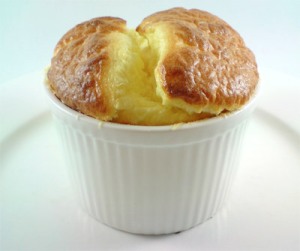
Classic Cheese Souffle
Ingredients
30g of plain flour
30g butter
1 cup warm milk
3 Tablespoons freshly grated Gruyere cheese
2 Tablespoons freshly grated Parmesan cheese
5 eggs separated
Salt and black or white pepper
Extra butter for coating ramekins
1-2 finely grated Parmesan cheese for coating ramekins
Butter for greasing baking paper if making the cheese sauce ahead of time.
Preheat oven to 200 degrees.
Butter a 1 litre ramekin dish or 2-3 smaller sized ramekins. Make sure the dishes are completely coated. Place a tablespoon of parmesan cheese into each ramekin and roll the cheese around to coat the inside of the ramekins. This will prevent the souffle sticking and facilitate rising. Tip the leftover parmesan into the next ramekin until they are all coated.
Melt 30g of butter in a small heavy based saucepan.
Stir in flour and cook on medium heat, stirring, for 2 minutes.
Gradually add milk stirring all the while.
Bring to a boil, then reduce heat and allow sauce to simmer for 5 minutes.
Stir in gruyere and 2 tablespoons of parmesan cheese. Then stir in the egg yolks one at a time.
Taste for seasoning.
Transfer to a large mixing bowl. If making the cheese sauce ahead of time, cover the sauce with a piece of buttered baking paper and let it sit at room temperature for 1 hour before adding the egg whites.
Whisk egg whites.
Take 1/3 of beaten egg whites and mix in the egg whites until until well incorporated into the cheese sauce. Then add another 1/3 of the beaten eggs whites and using a metal spoon lift and fold the egg whites through the mixture. Repeat with the remaining 1/3 of the egg white mixture until well incorporated and the mixture is frothy and spongy.
Carefully pour mixture into prepared ramekins. Run your thumb around the inside edge of the the souffle dish so it will rise with a flattened edge.
Place souffles on a tray and bake in the oven for 20-25 minutes depending on the size and number of dishes used. Do not open the oven during cooking. When cooked the centre should be well risen and brown. To check if the souffle is cooked, touch gently – the souffle should yield but not feel liquid. The top should be crusty with a creamy, saucy middle.
Remove souffle from the oven and serve immediately.
Notes:
The cheese sauce can be made a head of time to sit at room temperature an hour before adding the egg whites. Cover the sauce with a piece of buttered baking paper to prevent a hard skin forming.
Methods for avoiding your souffle spilling over the dish when cooking:
– If the temperature is too low, it will not “seize” the souffle quickly enough and the mixture will spill over as it is baked.
– Ramekins can be filled approximately 2cm lower than the top of the dish so when the souffle rises it does not spill over.
– Do not beat the egg whites until they are stiff or the souffles can rise too high and spill over the rims of the mould. Instead whip the eggwhites until they just begin to hold their shape.
Source: Il Viaggio Di Vetri: A Culinary Journey By Marc Vetri, David Joachim, Douglas Takeshi Wolfe